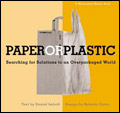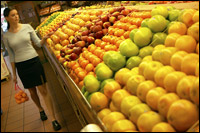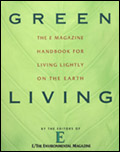
Food for thought.
I found out not too long ago that I am a LOHAS. Or, I should say, I found out that a gaggle of people I’ve never met think I am a LOHAS. These initials, as you may well know, stand for “lifestyles of health and sustainability.” We LOHAS shoppers are, according to our boosters in the marketing world, one of the fastest-growing sectors of the consumer universe.
Members of this tribe, the marketing literature explains, can be easily identified by our distinctive set of “holistic” consumer preferences. Our inclinations include green building (yep, I live in a straw-bale house the size of a refrigerator); alternative transportation (I do ride my bike a lot); “ecological” office products (well, if using both sides of the paper counts); and “spiritual products and services” (not so much, but I sure have a lot of friends who meditate). You get the idea. My tastes have been roughly, but fairly accurately, mapped out by strangers.
In many ways, the rise of this label is worth celebrating. Sustainability-minded shoppers are now numerous enough, and apparently rich enough, to occupy a very roomy sector of the marketplace (I imagine this abstract sector as an overlarge Wild Oats, its mile-long aisles filled with organic papayas and “spiritual products”). We, along with our bucks, do some substantial good for the planet. But LOHAS shopping patterns are not, by themselves, a blueprint for environmental progress — they’re simply a hodgepodge of conscious and unconscious tastes expressed by a particular subculture. And that’s why Green Living: The E Magazine Handbook for Living Lightly on the Earth is so troubling.
Green Living is far from a bad book. It is well researched and well written. It includes excellent lists of resources, many useful suggestions for political action, and thorough explanations of a broad variety of pressing issues. Its tone is light and cheerful, and salted with practicality. The only thing wrong with Green Living is its title: Better it be called A Field Guide to the LOHAS.
A true “handbook for living lightly on the earth” might prioritize its suggestions for readers. It might advise focusing personal conservation efforts on certain areas — say transportation, or home energy use — that tend to carry especially heavy environmental costs. But in Green Living, the chapters on transportation and energy are relegated to the back of the book. Closer to the front, we get advice on subjects such as natural health care and pet care, much of which, while commendable, has relatively little to do with the actual shrinkage of one’s ecological footprint. Thanks to this odd structure, Green Living unfortunately implies that getting a massage is at least as important to the planet as riding a bike to work.
The extensive suggestions for self-improvement also give the dispiriting impression that “green living” requires obsessive attention to minutiae, and an overhaul of nearly every aspect of existence. I’m sure the book is intended mainly as a reference guide, to be dipped into before a major purchase or decision, and the lists of information within each chapter are well organized. But such a large and detailed collection of advice cries out for some generally applicable guiding principles.
The chapter on food does contain a couple of pithy rules, such as “shop the perimeter of your typical supermarket” (to minimize the purchase of highly packaged foods) and “buy locally produced foods … whether they’re organic or not” (to avoid the environmental costs of transportation). But these useful tips are scattered throughout the text. The addition of a simple summary of key shopping considerations (e.g., “Do I really need this?”; “Where was it made?”; “Can I recycle the box?”) would help readers make quick decisions at the store, and avoid being tempted by overpackaged organic cotton socks.
And Green Living includes too few reminders that one of the best ways to “live lightly” is not to buy quite so much stuff. It does contain a worthy chapter on insulating children from advertising, and teaching them to live better on less. But the chapter on natural clothing, for instance, points readers to several high-end sources of organic cotton clothing, and a company that sells “a pair of incredibly flirty, red strappy dress sandals.” Supporting the organic-cotton industry is a fine idea, and I’m all for flirty and fun shoes — it’s important to remember that conservation isn’t necessarily about deprivation. But what about buying some cuteness at the local thrift store once in a while? Similarly, the chapter on ecotourism, with its descriptions of trips to the Himalayas and Australia, and its thoughtful tips on evaluating the real “eco” factor of various tour companies, does not mention that spending the occasional vacation exploring one’s own city or home state might be equally satisfying (and might, in its own way, require just as much cross-cultural communication).
E‘s book should be commended for describing a wide assortment of important environmental and personal health issues in plain language. But too often, Green Living makes green living look like quite an expensive proposition. And that, I’m afraid, is good news for just one demographic: the LOHAS marketeers.

Paper or Plastic
by Daniel Imhoff,
Sierra Club Books,
176 pgs., 2005.
One Word, Son
Better inspiration for creative consumption reduction can be found in Paper or Plastic: Searching for Solutions to an Overpackaged World. Much narrower in focus than Green Living, Paper or Plastic tackles the packaging industry, a very real and significant source of pollution and natural-resource exploitation.
This is, I must say, a weird book. Parts of it read like an introductory design textbook (“primary packaging has been called the ‘skin of commerce,’ because it both piques and simplifies the purchasing process”), while other sections include more traditional environmental commandments (“carry a mug”). But the eccentricities of Paper or Plastic are refreshing, and instructive.
Readers are not only reminded of the badness of petroleum products and virgin wood fiber, but are also shown how various economic and social pressures slow or block reform of the packaging industry. In addition, Paper or Plastic includes a couple of fascinating insights into the deeper meaning of packaging (who knew there was a deeper meaning?). “The central role of packaging in American culture,” writes one quoted scholar, “has been to replace human relationships … with expressive but less demanding containers.”
Paper or Plastic is, in many places, a grim read: author Daniel Imhoff doesn’t bother much with false hope. But he does profile several companies that have managed to change their packaging habits for the better, and these profiles mostly avoid rah-rah language in favor of sober talk about obstacles and accomplishments. Imhoff also dissects existing packaging types, providing clear explanations of their environmental advantages and disadvantages and pointing out directions for improvement. And he discusses far-reaching legislation, such as the extended producer responsibility laws now common in Europe and elsewhere, that are beginning to influence the packaging decisions of international companies in the United States. Positive change, though extremely difficult, seems far from impossible.
Perhaps the best part of Paper or Plastic is the final section, which features color photos of “beyond the box” packaging solutions. Here is some uplifting eye candy for the depressed environmentalist: edible shrink wraps made from pureed fruits and vegetables, toothbrushes made from yogurt cups, fruit bins transformed into owl boxes by a high-school shop class, and many other examples of reusable, recyclable, and salvaged packaging. These are, of course, all extremely small steps, each unlikely to have much individual impact on the waste stream. But they represent the kind of original and sensible thinking that, taken together, just might effect some real progress.



